Syntax
A dgsh script follows the syntax of a bash(1) shell script with the addition of multipipe blocks. A multipipe block contains one or more dgsh simple commands, other multipipe blocks, or pipelines of the previous two types of commands. The commands in a multipipe block are executed asynchronously (in parallel, in the background). Data may be redirected or piped into and out of a multipipe block. With multipipe blocks dgsh scripts form directed acyclic process graphs. It follows from the above description that multipipe blocks can be recursively composed.
As a simple example consider running the following command directly within dgsh
{{ echo hello & echo world & }} | paste
or by invoking dgsh with the command as an argument.
dgsh -c '{{ echo hello & echo world & }} | paste'
The command will run paste with input from the twoecho processes to output hello world.
This is equivalent to running the following bash command,
but with the flow of data appearing in the natural left-to-right order.
pasteIn the following larger example, which implements a directory listing similar to that of the Windows DIR command, the output of ls is distributed to six commands:awk, which sums the number of bytes and passes the result to the tr command that deletes newline characters,wc, which counts the number of files,awk, which counts the number of bytes,grep, which counts the number of directories and passes the result to the tr command that deletes newline characters, three
echocommands, which provide the headers of the data output by the commands described above. All six commands pass their output to thecatcommand, which gathers their outputs in order.FREE=$(df -h . | awk '!/Use%/{print $4}') ls -n | tee | {{ # Reorder fields in DIR-like way awk '!/^total/ {print $6, $7, $8, $1, sprintf("%8d", $5), $9}' & # Count number of files wc -l | tr -d \\n & # Print label for number of files echo -n ' File(s) ' & # Tally number of bytes awk '{s += $5} END {printf("%d bytes\n", s)}' & # Count number of directories grep -c '^d' | tr -d \\n & # Print label for number of dirs and calculate free bytes echo " Dir(s) $FREE bytes free" & }} | catFormally, dgsh extends the syntax of the (modified) Unix Bourne-shell when
bashprovided with the--dgshargument as follows.<dgsh_block> ::= '{{' <dgsh_list> '}}'<dgsh_list> ::= <dgsh_list_item> '&'<dgsh_list_item> <dgsh_list><dgsh_list_item> ::= <simple_command><dgsh_block><dgsh_list_item> '|' <dgsh_list_item>
Compression benchmark
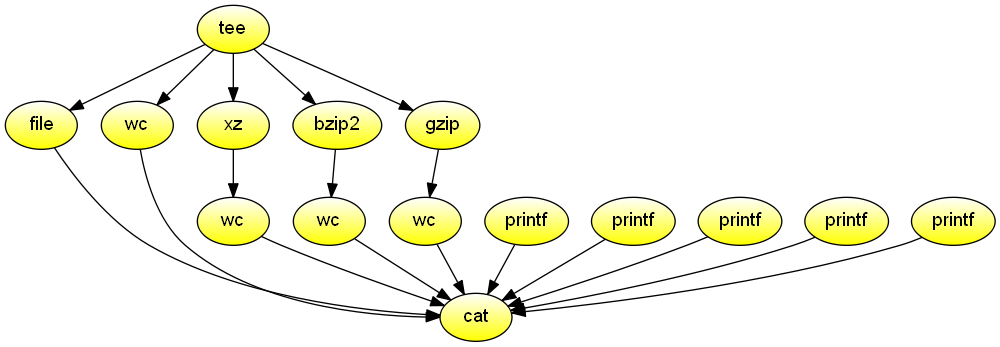
Report file type, length, and compression performance for data received from the standard input. The data never touches the disk. Demonstrates the use of an output multipipe to source many commands from one followed by an input multipipe to sink to one command the output of many and the use of dgsh-tee that is used both to propagate the same input to many commands and collect output from many commands orderly in a way that is transparent to users.
#!/usr/bin/env dgsh
tee |
{{
echo -n 'File type:' &
file - &
echo -n 'Original size:' &
wc -c &
echo -n 'xz:' &
xz -c | wc -c &
echo -n 'bzip2:' &
bzip2 -c | wc -c &
echo -n 'gzip:' &
gzip -c | wc -c &
}} |
catGit commit statistics
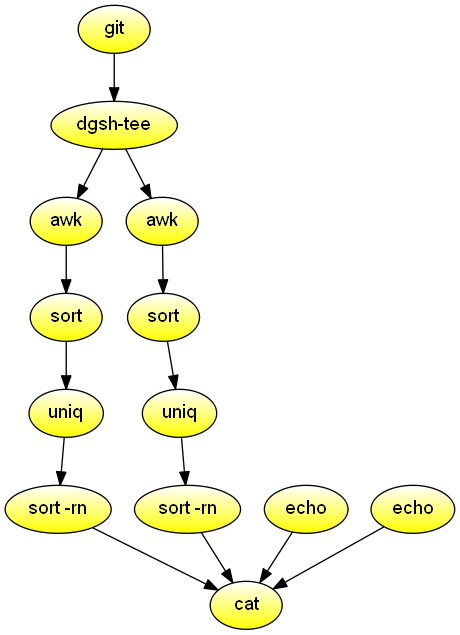
Process the git history, and list the authors and days of the week ordered by the number of their commits. Demonstrates streams and piping through a function.
#!/usr/bin/env dgsh
forder()
{
sort |
uniq -c |
sort -rn
}
export -f forder
git log --format="%an:%ad" --date=default "$@" |
tee |
{{
echo "Authors ordered by number of commits" &
# Order by frequency
awk -F: '{print $1}' |
call 'forder' &
echo "Days ordered by number of commits" &
# Order by frequency
awk -F: '{print substr($2, 1, 3)}' |
call 'forder' &
}} |
catC code metrics

Process a directory containing C source code, and produce a summary of various metrics. Demonstrates nesting, commands without input.
#!/usr/bin/env dgsh
{{
# C and header code
find "$@" \( -name \*.c -or -name \*.h \) -type f -print0 |
tee |
{{
# Average file name length
# Convert to newline separation for counting
echo -n 'FNAMELEN: ' &
tr \\0 \\n |
# Remove path
sed 's|^.*/||' |
# Maintain average
awk '{s += length($1); n++} END {
if (n>0)
print s / n;
else
print 0; }' &
xargs -0 /bin/cat |
tee |
{{
# Remove strings and comments
sed 's/#/@/g;s/\\[\\"'\'']/@/g;s/"[^"]*"/""/g;'"s/'[^']*'/''/g" |
cpp -P 2>/dev/null |
tee |
{{
# Structure definitions
echo -n 'NSTRUCT: ' &
egrep -c 'struct[ ]*{|struct[ ]*[a-zA-Z_][a-zA-Z0-9_]*[ ]*{' &
#}} (match preceding openings)
# Type definitions
echo -n 'NTYPEDEF: ' &
grep -cw typedef &
# Use of void
echo -n 'NVOID: ' &
grep -cw void &
# Use of gets
echo -n 'NGETS: ' &
grep -cw gets &
# Average identifier length
echo -n 'IDLEN: ' &
tr -cs 'A-Za-z0-9_' '\n' |
sort -u |
awk '/^[A-Za-z]/ { len += length($1); n++ } END {
if (n>0)
print len / n;
else
print 0; }' &
}} &
# Lines and characters
echo -n 'CHLINESCHAR: ' &
wc -lc |
awk '{OFS=":"; print $1, $2}' &
# Non-comment characters (rounded thousands)
# -traditional avoids expansion of tabs
# We round it to avoid failing due to minor
# differences between preprocessors in regression
# testing
echo -n 'NCCHAR: ' &
sed 's/#/@/g' |
cpp -traditional -P 2>/dev/null |
wc -c |
awk '{OFMT = "%.0f"; print $1/1000}' &
# Number of comments
echo -n 'NCOMMENT: ' &
egrep -c '/\*|//' &
# Occurences of the word Copyright
echo -n 'NCOPYRIGHT: ' &
grep -ci copyright &
}} &
}} &
# C files
find "$@" -name \*.c -type f -print0 |
tee |
{{
# Convert to newline separation for counting
tr \\0 \\n |
tee |
{{
# Number of C files
echo -n 'NCFILE: ' &
wc -l &
# Number of directories containing C files
echo -n 'NCDIR: ' &
sed 's,/[^/]*$,,;s,^.*/,,' |
sort -u |
wc -l &
}} &
# C code
xargs -0 /bin/cat |
tee |
{{
# Lines and characters
echo -n 'CLINESCHAR: ' &
wc -lc |
awk '{OFS=":"; print $1, $2}' &
# C code without comments and strings
sed 's/#/@/g;s/\\[\\"'\'']/@/g;s/"[^"]*"/""/g;'"s/'[^']*'/''/g" |
cpp -P 2>/dev/null |
tee |
{{
# Number of functions
echo -n 'NFUNCTION: ' &
grep -c '^{' &
# Number of gotos
echo -n 'NGOTO: ' &
grep -cw goto &
# Occurrences of the register keyword
echo -n 'NREGISTER: ' &
grep -cw register &
# Number of macro definitions
echo -n 'NMACRO: ' &
grep -c '@[ ]*define[ ][ ]*[a-zA-Z_][a-zA-Z0-9_]*(' &
# Number of include directives
echo -n 'NINCLUDE: ' &
grep -c '@[ ]*include' &
# Number of constants
echo -n 'NCONST: ' &
grep -ohw '[0-9][x0-9][0-9a-f]*' | wc -l &
}} &
}} &
}} &
# Header files
echo -n 'NHFILE: ' &
find "$@" -name \*.h -type f |
wc -l &
}} |
# Gather and print the results
cat
Find duplicate files

List the names of duplicate files in the specified directory. Demonstrates the combination of streams with a relational join.
#!/usr/bin/env dgsh
# Create list of files
find "$@" -type f |
# Produce lines of the form
# MD5(filename)= 811bfd4b5974f39e986ddc037e1899e7
xargs openssl md5 |
# Convert each line into a "filename md5sum" pair
sed 's/^MD5(//;s/)= / /' |
# Sort by MD5 sum
sort -k2 |
tee |
{{
# Print an MD5 sum for each file that appears more than once
awk '{print $2}' | uniq -d &
# Promote the stream to gather it
cat &
}} |
# Join the repeated MD5 sums with the corresponding file names
# Join expects two inputs, second will come from scatter
# XXX make streaming input identifiers transparent to users
join -2 2 |
# Output same files on a single line
awk '
BEGIN {ORS=""}
$1 != prev && prev {print "\n"}
END {if (prev) print "\n"}
{if (prev) print " "; prev = $1; print $2}'Highlight misspelled words
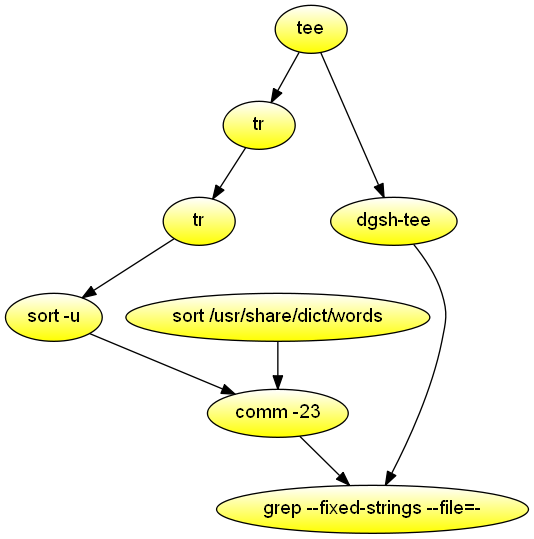
Highlight the words that are misspelled in the command's first argument. Demonstrates stream processing with multipipes and the avoidance of pass-through constructs to avoid deadlocks.
#!/usr/bin/env dgsh
export LC_ALL=C
tee |
{{
{{
# Find errors
tr -cs A-Za-z \\n |
tr A-Z a-z |
sort -u &
# Ensure dictionary is sorted consistently with our settings
sort /usr/share/dict/words &
}} |
comm -23 &
cat &
}} |
grep -F -f - -i --color -w -C 2Word properties
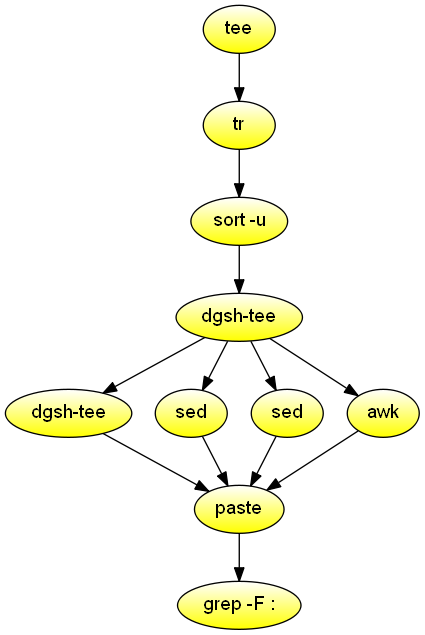
Read text from the standard input and list words containing a two-letter palindrome, words containing four consonants, and words longer than 12 characters.
#!/usr/bin/env dgsh
# Consistent sorting across machines
export LC_ALL=C
# Stream input from file
cat $1 |
# Split input one word per line
tr -cs a-zA-Z \\n |
# Create list of unique words
sort -u |
tee |
{{
# Pass through the original words
cat &
# List two-letter palindromes
sed 's/.*\(.\)\(.\)\2\1.*/p: \1\2-\2\1/;t
g' &
# List four consecutive consonants
sed -E 's/.*([^aeiouyAEIOUY]{4}).*/c: \1/;t
g' &
# List length of words longer than 12 characters
awk '{if (length($1) > 12) print "l:", length($1);
else print ""}' &
}} |
# Paste the four streams side-by-side
paste |
# List only words satisfying one or more properties
fgrep :Web log reporting

Creates a report for a fixed-size web log file read from the standard input. Demonstrates the combined use of multipipe blocks, writeval and readval to store and retrieve values, and functions in the scatter block. Used to measure throughput increase achieved through parallelism.
#!/usr/bin/env dgsh
# Output the top X elements of the input by the number of their occurrences
# X is the first argument
toplist()
{
uniq -c | sort -rn | head -$1
echo
}
# Output the argument as a section header
header()
{
echo
echo "$1"
echo "$1" | sed 's/./-/g'
}
# Consistent sorting
export LC_ALL=C
export -f toplist
export -f header
cat <<EOF
WWW server statistics
=====================
Summary
-------
EOF
tee |
{{
awk '{s += $NF} END {print s / 1024 / 1024 / 1024}' |
tee |
{{
# Number of transferred bytes
echo -n 'Number of Gbytes transferred: ' &
cat &
dgsh-writeval -s nXBytes &
}} &
# Number of log file bytes
echo -n 'MBytes log file size: ' &
wc -c |
awk '{print $1 / 1024 / 1024}' &
# Host names
awk '{print $1}' |
tee |
{{
wc -l |
tee |
{{
# Number of accesses
echo -n 'Number of accesses: ' &
cat &
dgsh-writeval -s nAccess &
}} &
# Sorted hosts
sort |
tee |
{{
# Unique hosts
uniq |
tee |
{{
# Number of hosts
echo -n 'Number of hosts: ' &
wc -l &
# Number of TLDs
echo -n 'Number of top level domains: ' &
awk -F. '$NF !~ /[0-9]/ {print $NF}' |
sort -u |
wc -l &
}} &
# Top 10 hosts
{{
call 'header "Top 10 Hosts"' &
call 'toplist 10' &
}} &
}} &
# Top 20 TLDs
{{
call 'header "Top 20 Level Domain Accesses"' &
awk -F. '$NF !~ /^[0-9]/ {print $NF}' |
sort |
call 'toplist 20' &
}} &
# Domains
awk -F. 'BEGIN {OFS = "."}
$NF !~ /^[0-9]/ {$1 = ""; print}' |
sort |
tee |
{{
# Number of domains
echo -n 'Number of domains: ' &
uniq |
wc -l &
# Top 10 domains
{{
call 'header "Top 10 Domains"' &
call 'toplist 10' &
}} &
}} &
}} &
# Hosts by volume
{{
call 'header "Top 10 Hosts by Transfer"' &
awk ' {bytes[$1] += $NF}
END {for (h in bytes) print bytes[h], h}' |
sort -rn |
head -10 &
}} &
# Sorted page name requests
awk '{print $7}' |
sort |
tee |
{{
# Top 20 area requests (input is already sorted)
{{
call 'header "Top 20 Area Requests"' &
awk -F/ '{print $2}' |
call 'toplist 20' &
}} &
# Number of different pages
echo -n 'Number of different pages: ' &
uniq |
wc -l &
# Top 20 requests
{{
call 'header "Top 20 Requests"' &
call 'toplist 20' &
}} &
}} &
# Access time: dd/mmm/yyyy:hh:mm:ss
awk '{print substr($4, 2)}' |
tee |
{{
# Just dates
awk -F: '{print $1}' |
tee |
{{
uniq |
wc -l |
tee |
{{
# Number of days
echo -n 'Number of days: ' &
cat &
#|store:nDays
echo -n 'Accesses per day: ' &
awk '
BEGIN {
"dgsh-readval -l -x -q -s nAccess" | getline NACCESS;}
{print NACCESS / $1}' &
echo -n 'MBytes per day: ' &
awk '
BEGIN {
"dgsh-readval -l -x -q -s nXBytes" | getline NXBYTES;}
{print NXBYTES / $1 / 1024 / 1024}' &
}} &
{{
call 'header "Accesses by Date"' &
uniq -c &
}} &
# Accesses by day of week
{{
call 'header "Accesses by Day of Week"' &
sed 's|/|-|g' |
call '(date -f - +%a 2>/dev/null || gdate -f - +%a)' |
sort |
uniq -c |
sort -rn &
}} &
}} &
# Hour
{{
call 'header "Accesses by Local Hour"' &
awk -F: '{print $2}' |
sort |
uniq -c &
}} &
}} &
}} |
catText properties
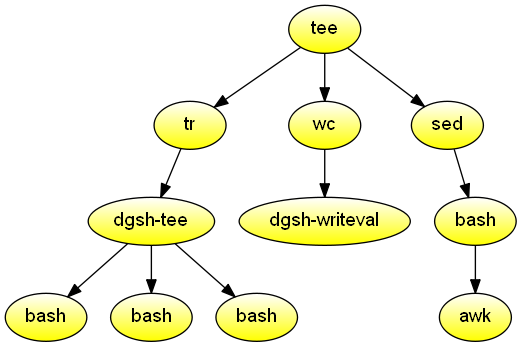
Read text from the standard input and create files containing word, character, digram, and trigram frequencies.
#!/usr/bin/env dgsh
# Consistent sorting across machines
export LC_ALL=C
# Convert input into a ranked frequency list
ranked_frequency()
{
awk '{count[$1]++} END {for (i in count) print count[i], i}' |
# We want the standard sort here
sort -rn
}
# Convert standard input to a ranked frequency list of specified n-grams
ngram()
{
local N=$1
perl -ne 'for ($i = 0; $i < length($_) - '$N'; $i++) {
print substr($_, $i, '$N'), "\n";
}' |
ranked_frequency
}
export -f ranked_frequency
export -f ngram
tee <$1 |
{{
# Split input one word per line
tr -cs a-zA-Z \\n |
tee |
{{
# Digram frequency
call 'ngram 2 >digram.txt' &
# Trigram frequency
call 'ngram 3 >trigram.txt' &
# Word frequency
call 'ranked_frequency >words.txt' &
}} &
# Store number of characters to use in awk below
wc -c |
dgsh-writeval -s nchars &
# Character frequency
sed 's/./&\
/g' |
# Print absolute
call 'ranked_frequency' |
awk 'BEGIN {
"dgsh-readval -l -x -q -s nchars" | getline NCHARS
OFMT = "%.2g%%"}
{print $1, $2, $1 / NCHARS * 100}' > character.txt &
}}C/C++ symbols that should be static

Given as an argument a directory containing object files, show which symbols are declared with global visibility, but should have been declared with file-local (static) visibility instead. Demonstrates the use of dgsh-capable comm (1) to combine data from two sources.
#!/usr/bin/env dgsh
# Find object files
find "$1" -name \*.o |
# Print defined symbols
xargs nm |
tee |
{{
# List all defined (exported) symbols
awk 'NF == 3 && $2 ~ /[A-Z]/ {print $3}' | sort &
# List all undefined (imported) symbols
awk '$1 == "U" {print $2}' | sort &
}} |
# Print exports that are not imported
comm -23
Hierarchy map

Given two directory hierarchies A and B passed as input arguments (where these represent a project at different parts of its lifetime) copy the files of hierarchy A to a new directory, passed as a third argument, corresponding to the structure of directories in B. Demonstrates the use of join to process results from two inputs and the use of gather to order asynchronously produced results.
#!/usr/bin/env dgsh
if [ ! -d "$1" -o ! -d "$2" -o -z "$3" ]
then
echo "Usage: $0 dir-1 dir-2 new-dir-name" 1>&2
exit 1
fi
NEWDIR="$3"
export LC_ALL=C
line_signatures()
{
find $1 -type f -name '*.[chly]' -print |
# Split path name into directory and file
sed 's|\(.*\)/\([^/]*\)|\1 \2|' |
while read dir file
do
# Print "directory filename content" of lines with
# at least one alphabetic character
# The fields are separated by and
sed -n "/[a-z]/s|^|$dir$file|p" "$dir/$file"
done |
# Error: multi-character tab '\001\001'
sort -T `pwd` -t -k 2
}
export -f line_signatures
{{
# Generate the signatures for the two hierarchies
call 'line_signatures "$1"' -- "$1" &
call 'line_signatures "$1"' -- "$2" &
}} |
# Join signatures on file name and content
join -t -1 2 -2 2 |
# Print filename dir1 dir2
sed 's///g' |
awk -F 'BEGIN{OFS=" "}{print $1, $3, $4}' |
# Unique occurrences
sort -u |
tee |
{{
# Commands to copy
awk '{print "mkdir -p '$NEWDIR'/" $3 ""}' |
sort -u &
awk '{print "cp " $2 "/" $1 " '$NEWDIR'/" $3 "/" $1 ""}' &
}} |
# Order: first make directories, then copy files
# TODO: dgsh-tee does not pass along first incoming stream
cat |
shPlot git committer activity over time
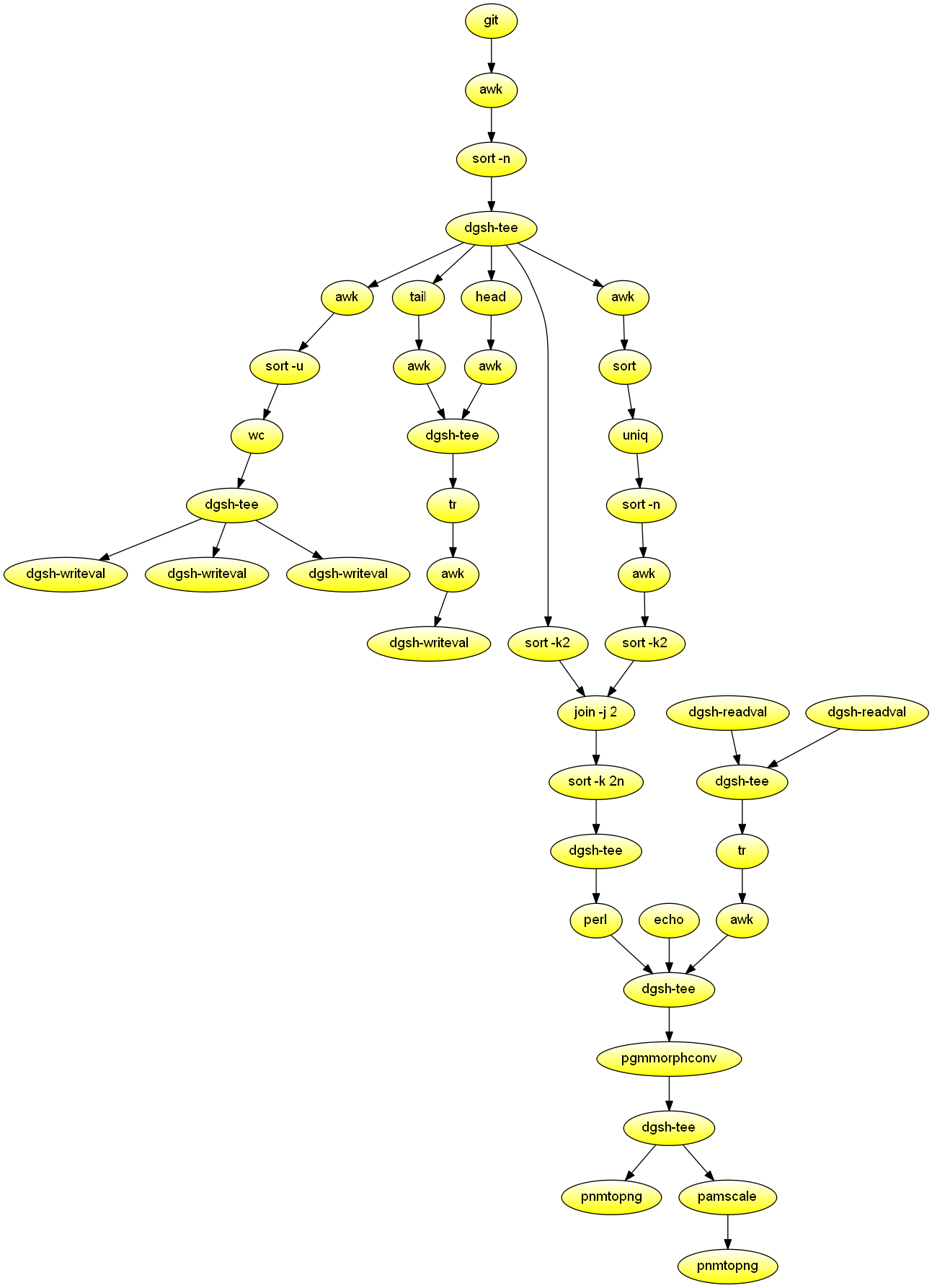
Process the git history, and create two PNG diagrams depicting committer activity over time. The most active committers appear at the center vertical of the diagram. Demonstrates image processing, mixining of synchronous and asynchronous processing in a scatter block, and the use of an dgsh-compliant join command.
#!/usr/bin/env dgsh
# Commit history in the form of ascending Unix timestamps, emails
git log --pretty=tformat:'%at %ae' |
# Filter records according to timestamp: keep (100000, now) seconds
awk 'NF == 2 && $1 > 100000 && $1 < '`date +%s` |
sort -n |
tee |
{{
{{
# Calculate number of committers
awk '{print $2}' |
sort -u |
wc -l |
tee |
{{
dgsh-writeval -s committers1 &
dgsh-writeval -s committers2 &
dgsh-writeval -s committers3 &
}} &
# Calculate last commit timestamp in seconds
tail -1 |
awk '{print $1}' &
# Calculate first commit timestamp in seconds
head -1 |
awk '{print $1}' &
}} |
# Gather last and first commit timestamp
tee |
# Make one space-delimeted record
tr '\n' ' ' |
# Compute the difference in days
awk '{print int(($1 - $2) / 60 / 60 / 24)}' |
# Store number of days
dgsh-writeval -s days &
sort -k2 & # <timestamp, email>
# Place committers left/right of the median
# according to the number of their commits
awk '{print $2}' |
sort |
uniq -c |
sort -n |
awk '
BEGIN {
"dgsh-readval -l -x -q -s committers1" | getline NCOMMITTERS
l = 0; r = NCOMMITTERS;}
{print NR % 2 ? l++ : --r, $2}' |
sort -k2 & # <left/right, email>
}} |
# Join committer positions with commit time stamps
# based on committer email
join -j 2 | # <email, timestamp, left/right>
# Order by timestamp
sort -k 2n |
tee |
{{
# Create portable bitmap
echo 'P1' &
{{
dgsh-readval -l -q -s committers2 &
dgsh-readval -l -q -s days &
}} |
cat |
tr '\n' ' ' |
awk '{print $1, $2}' &
perl -na -e '
BEGIN { open(my $ncf, "-|", "dgsh-readval -l -x -q -s committers3");
$ncommitters = <$ncf>;
@empty[$ncommitters - 1] = 0; @committers = @empty; }
sub out { print join("", map($_ ? "1" : "0", @committers)), "\n"; }
$day = int($F[1] / 60 / 60 / 24);
$pday = $day if (!defined($pday));
while ($day != $pday) {
out();
@committers = @empty;
$pday++;
}
$committers[$F[2]] = 1;
END { out(); }
' &
}} |
cat |
# Enlarge points into discs through morphological convolution
pgmmorphconv -erode <(
cat <<EOF
P1
7 7
1 1 1 0 1 1 1
1 1 0 0 0 1 1
1 0 0 0 0 0 1
0 0 0 0 0 0 0
1 0 0 0 0 0 1
1 1 0 0 0 1 1
1 1 1 0 1 1 1
EOF
) |
tee |
{{
# Full-scale image
pnmtopng >large.png &
# A smaller image
pamscale -width 640 |
pnmtopng >small.png &
}}
# Close dgsh-writeval
#dgsh-readval -l -x -q -s committers
Waves: 2D Fourier transforms

Create two graphs: 1) a broadened pulse and the real part of its 2D Fourier transform, and 2) a simulated air wave and the amplitude of its 2D Fourier transform. Demonstrates using the tools of the Madagascar shared research environment for computational data analysis in geophysics and related fields. Also demonstrates the use of two scatter blocks in the same script, and the used of named streams.
#!/usr/bin/env dgsh
mkdir -p Fig
# The SConstruct SideBySideIso "Result" method
side_by_side_iso()
{
vppen size=r vpstyle=n gridnum=2,1 /dev/stdin $*
}
export -f side_by_side_iso
# A broadened pulse and the real part of its 2D Fourier transform
sfspike n1=64 n2=64 d1=1 d2=1 nsp=2 k1=16,17 k2=5,5 mag=16,16 \
label1='time' label2='space' unit1= unit2= |
sfsmooth rect2=2 |
sfsmooth rect2=2 |
tee |
{{
sfgrey pclip=100 wanttitle=n &
#dgsh-writeval -s pulse.vpl &
sffft1 |
sffft3 axis=2 pad=1 |
sfreal |
tee |
{{
sfwindow f1=1 |
sfreverse which=3 &
cat &
#dgsh-tee -I |
#dgsh-writeval -s ft2d &
}} |
sfcat axis=1 "<|" | # dgsh-readval
sfgrey pclip=100 wanttitle=n \
label1="1/time" label2="1/space" &
#dgsh-writeval -s ft2d.vpl &
}} |
call 'side_by_side_iso "<|" \
yscale=1.25 >Fig/ft2dofpulse.vpl' &
# A simulated air wave and the amplitude of its 2D Fourier transform
sfspike n1=64 d1=1 o1=32 nsp=4 k1=1,2,3,4 mag=1,3,3,1 \
label1='time' unit1= |
sfspray n=32 d=1 o=0 |
sfput label2=space |
sflmostretch delay=0 v0=-1 |
tee |
{{
sfwindow f2=1 |
sfreverse which=2 &
cat &
#dgsh-tee -I | dgsh-writeval -s air &
}} |
sfcat axis=2 "<|" |
tee |
{{
sfgrey pclip=100 wanttitle=n &
#| dgsh-writeval -s airtx.vpl &
sffft1 |
sffft3 sign=1 |
tee |
{{
sfreal &
#| dgsh-writeval -s airftr &
sfimag &
#| dgsh-writeval -s airfti &
}} |
sfmath nostdin=y re=/dev/stdin im="<|" output="sqrt(re*re+im*im)" |
tee |
{{
sfwindow f1=1 |
sfreverse which=3 &
cat &
#dgsh-tee -I | dgsh-writeval -s airft1 &
}} |
sfcat axis=1 "<|" |
sfgrey pclip=100 wanttitle=n label1="1/time" \
label2="1/space" &
#| dgsh-writeval -s airfk.vpl
}} |
call 'side_by_side_iso "<|" \
yscale=1.25 >Fig/airwave.vpl' &
#call 'side_by_side_iso airtx.vpl airfk.vpl \
wait
Nuclear magnetic resonance processing

Nuclear magnetic resonance in-phase/anti-phase channel conversion and processing in heteronuclear single quantum coherence spectroscopy. Demonstrate processing of NMR data using the NMRPipe family of programs.
#!/usr/bin/env dgsh
# The conversion is configured for the following file:
# http://www.bmrb.wisc.edu/ftp/pub/bmrb/timedomain/bmr6443/timedomain_data/c13-hsqc/june11-se-6426-CA.fid/fid
var2pipe -in $1 \
-xN 1280 -yN 256 \
-xT 640 -yT 128 \
-xMODE Complex -yMODE Complex \
-xSW 8000 -ySW 6000 \
-xOBS 599.4489584 -yOBS 60.7485301 \
-xCAR 4.73 -yCAR 118.000 \
-xLAB 1H -yLAB 15N \
-ndim 2 -aq2D States \
-verb |
tee |
{{
# IP/AP channel conversion
# See http://tech.groups.yahoo.com/group/nmrpipe/message/389
nmrPipe |
nmrPipe -fn SOL |
nmrPipe -fn SP -off 0.5 -end 0.98 -pow 2 -c 0.5 |
nmrPipe -fn ZF -auto |
nmrPipe -fn FT |
nmrPipe -fn PS -p0 177 -p1 0.0 -di |
nmrPipe -fn EXT -left -sw -verb |
nmrPipe -fn TP |
nmrPipe -fn COADD -cList 1 0 -time |
nmrPipe -fn SP -off 0.5 -end 0.98 -pow 1 -c 0.5 |
nmrPipe -fn ZF -auto |
nmrPipe -fn FT |
nmrPipe -fn PS -p0 0 -p1 0 -di |
nmrPipe -fn TP |
nmrPipe -fn POLY -auto -verb >A &
nmrPipe |
nmrPipe -fn SOL |
nmrPipe -fn SP -off 0.5 -end 0.98 -pow 2 -c 0.5 |
nmrPipe -fn ZF -auto |
nmrPipe -fn FT |
nmrPipe -fn PS -p0 177 -p1 0.0 -di |
nmrPipe -fn EXT -left -sw -verb |
nmrPipe -fn TP |
nmrPipe -fn COADD -cList 0 1 -time |
nmrPipe -fn SP -off 0.5 -end 0.98 -pow 1 -c 0.5 |
nmrPipe -fn ZF -auto |
nmrPipe -fn FT |
nmrPipe -fn PS -p0 -90 -p1 0 -di |
nmrPipe -fn TP |
nmrPipe -fn POLY -auto -verb >B &
}}
# We use temporary files rather than streams, because
# addNMR mmaps its input files. The diagram displayed in the
# example shows the notional data flow.
addNMR -in1 A -in2 B -out A+B.dgsh.ft2 -c1 1.0 -c2 1.25 -add
addNMR -in1 A -in2 B -out A-B.dgsh.ft2 -c1 1.0 -c2 1.25 -sub
FFT calculation
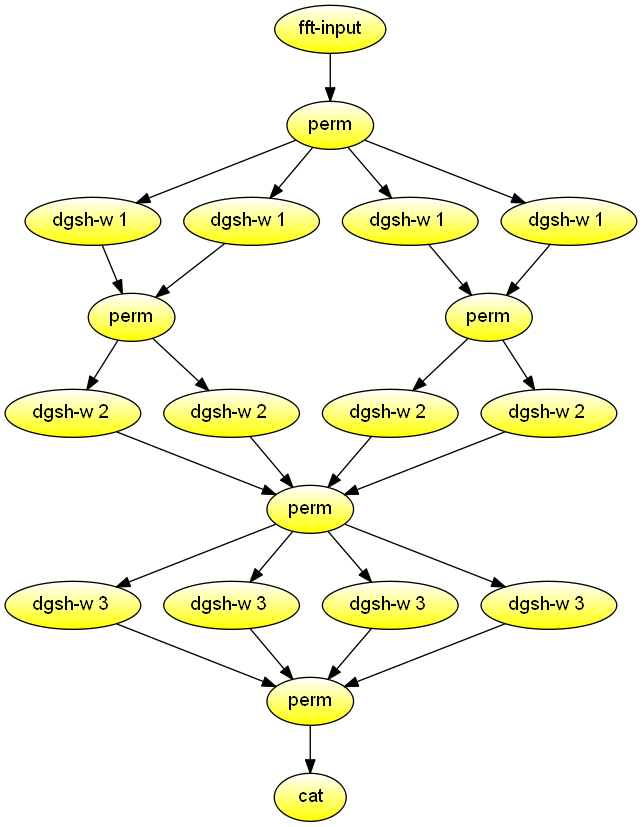
Calculate the iterative FFT for n = 8 in parallel. Demonstrates combined use of permute and multipipe blocks.
#!/usr/bin/env dgsh
fft-input $1 |
perm 1,5,3,7,2,6,4,8 |
{{
{{
w 1 0 &
w 1 0 &
}} |
perm 1,3,2,4 |
{{
w 2 0 &
w 2 1 &
}} &
{{
w 1 0 &
w 1 0 &
}} |
perm 1,3,2,4 |
{{
w 2 0 &
w 2 1 &
}} &
}} |
perm 1,5,3,7,2,6,4,8 |
{{
w 3 0 &
w 3 1 &
w 3 2 &
w 3 3 &
}} |
perm 1,5,2,6,3,7,4,8 |
catManage results

Combine, update, aggregate, summarise results files, such as logs. Demonstrates combined use of tools adapted for use with dgsh: sort, comm, paste, join, and diff.
#!/usr/bin/env dgsh
PSDIR=$1
cp $PSDIR/results $PSDIR/res
# Sort result files
{{
sort $PSDIR/f4s &
sort $PSDIR/f5s &
}} |
# Remove noise
comm |
{{
# Paste to master results file
paste $PSDIR/res > results &
# Join with selected records
join $PSDIR/top > top_results &
# Diff from previous results file
diff $PSDIR/last > diff_last &
}}Reorder columns
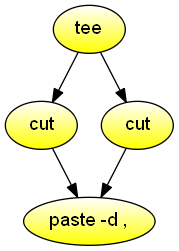
Reorder columns in a CSV document. Demonstrates the combined use of tee, cut, and paste.
#!/usr/bin/env dgsh
tee |
{{
cut -d , -f 5-6 - &
cut -d , -f 2-4 - &
}} |
paste -d ,Directory listing
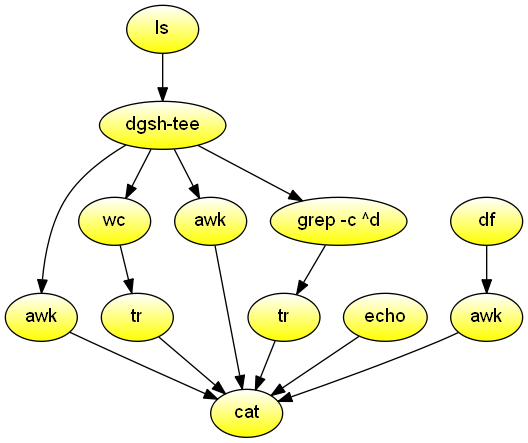
Windows-like DIR command for the current directory.
Nothing that couldn't be done with ls -l | awk.
Demonstrates combined use of stores and streams.
#!/usr/bin/env dgsh
FREE=`df -h . | awk '!/Use%/{print $4}'`
ls -n |
tee |
{{
# Reorder fields in DIR-like way
awk '!/^total/ {print $6, $7, $8, $1, sprintf("%8d", $5), $9}' &
# Count number of files
wc -l | tr -d \\n &
# Print label for number of files
echo -n ' File(s) ' &
# Tally number of bytes
awk '{s += $5} END {printf("%d bytes\n", s)}' &
# Count number of directories
grep -c '^d' | tr -d \\n &
# Print label for number of dirs and calculate free bytes
echo " Dir(s) $FREE bytes free" &
}} |
cat